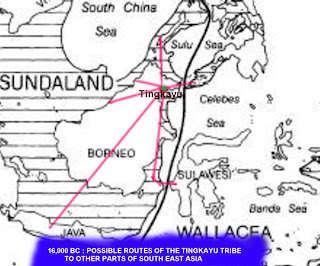

We pick up from our last story that took place around 16,000 BC when the Tingkayu Lake drained out. The tribe scattered to other parts of South East Asia. Some might even met other tribes, their cousins, who had been there earlier.
That time the sea level was up to 300 or 400 feet lower than today so that the group that travelled south through Balikpapan would come to the shore where they can clearly see the highland of Mamuju in Sulawesi.

The water that separated them from the land that looked so rich and green was only a few kilometers distance. Being adventurous and curious, some took up to the sea with rafts and crossed over to settle in Sulawesi. It is thus not surprising that later on the people of Sulawesi emerged as one of the most prominent seafarers. Their ancestors are the pioneers of sea travel.
Back in the nearby Baturong Caves, the remaining tribe continued with their usual life as in Tingkayu. However, they did not stay for long. Around 10,000 BC the shelter at Baturong was in turn abandoned. It was the end of the Ice Age. The massive blocks of ice that had covered most part of Europe and Northern Asia melted and flowed down, the sea level rose separating Borneo from mainland Asia, Palawan, Sumatra and Java. Borneo found its present shoreline and the coastal environment moved significantly towards the Madai-Baturong region.


Coastal resources were laid within an easy day’s walk from the Madai Caves. To get closer to the new resources, the people of Baturong moved in to two of the large caves at Madai, Agop Atas and Agop Sarapad. Archaeological studies proved that the two shelters were intensely inhabited during the early Holocene, between 10,000 and 5,000 BC.
No comments:
Post a Comment